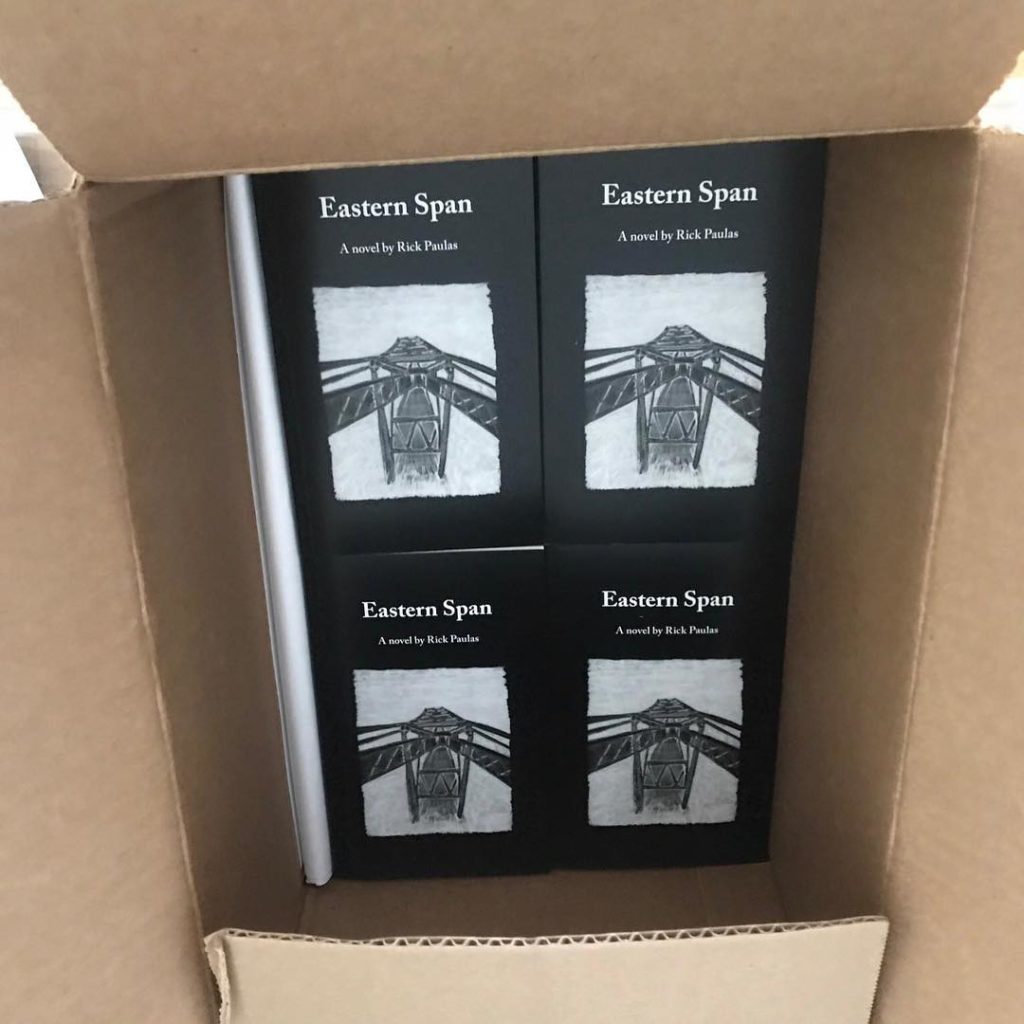Reprinted from Street Spirit
By Alastair Boone
I could describe Eastern Span in two ways. I could tell you that it is a noir novel set in 2013-14 Oakland about a gig-economy sleuth named Pug, on a meandering hunt to find a friend who has mysteriously disappeared. Along the way, he stumbles upon a housing conspiracy wrought by the kind of evil developers that we all suspect exist, but have never actually seen in the light of day.
I could also tell you that it is a portrait of Oakland, frozen in time. Pug drinks at the city’s classic dives, like Ruby Room and The Avenue. He parties at underground house shows in West Oakland. He visits at long-standing homeless encampments, such as Here/There. And he watches as houses are knocked to the ground, scaffolding is erected, and neighborhoods are devastated by gentrification. Readers who are familiar with Oakland can breathe in a scene that feels like home. Readers who are not can get a taste of the city through the author’s vivid descriptions of classic Oakland sights, such as “the massive white harbor cranes loom[ing] in the background like pallbearers waiting for their cue.”
Both descriptions would be true.
Paulas was born in Oak Forest, Illinois—a suburb near Chicago. He lived in Oakland for six years before moving to New York City in June. While living in Oakland he worked as a freelance journalist who wrote about the city around him. Often, he notes, this led him to stories about the housing crisis. “In my opinion, that’s really THE story of the Bay right now,” he told Street Spirit. Most recently, he published a story about the history of the Albany Bulb in Curbed, and an in-depth profile of East Bay lawyer Osha Neumann in the San Francisco Chronicle.
Eastern Span is Paulas’ debut novel. It is being distributed in the Bay Area by the people who sell Street Spirit in the East Bay, and those who sell Street Sheet in San Francisco. Why? We spoke to Paulas to find out. (Our conversation has been edited and condensed.)
Alastair Boone: What inspired you to write Eastern Span?
Rick Paulas: Mainly, two big events happened at the end of 2016: Trump and the Ghost Ship fire. They seem like distinctly separate things, and largely are, but to me they were entwined within some of the same systems—Trump’s career as a blowhard real estate mogul who spent his career seeking ways to raise property values, often by kicking out poor minorities; the lack of artistic, “free” spaces left in the Bay due to landlords raising their property values by converting to lofts left Ghost Ship as one of the few gathering places left.
Beyond those, I’ve been reporting on homeless evictions—for publications, or just for Twitter sometimes—and simply living in the ether or friends having to move out of town because they can’t afford it. Once I figured out I wanted to write about the effects of the commodification of property, I wanted to trick people into reading it, hence, the noir plot.
AB: Your book really grounds the reader in Oakland. Often times, it grounds the reader in Oakland’s homeless encampments. How come Oakland’s encampments are so central to the geography of Eastern Span? Why not just focus on house shows or squats to convey the underground scene?
RP: As far as I can tell, it’s all interconnected. The system that’s pushed artists into underground spaces and squats is the same one that’s evicted (often minority) low-income tenants from their homes is the same one that answers the complaints of property owners by evicting mutual-aid encampments without giving them anywhere else to go. The encampments, particularly “Here/There,” are so out in the open that I felt it’d give the reader, presumably local, more grounding to know where the action was taking place.
I suppose, if the point of any writing is to illuminate a perceptive or way of seeing, my goal with this was to provide a pair of glasses readers could hold up as they viewed the city. I’d love for someone to be reading this on the BART, look out the window, and see a description of a building or area or one of those shipping cranes I was trying to describe.
AB: Given the prevalence of encampments in your novel, the word “homeless” does not appear very often. Is there a reason for this?
RP: I wanted to present people as people, not as part of a category, which inherently comes with preconceptions of how they got that designation. I suppose that’s why I stayed away from the term for the most part.
AB: I read on Twitter that having Eastern Span distributed by street vendors has been a dream of yours since before you finished writing the novel. Why?
RP: Whenever I write about homeless folks or encampments, I always have a squishy bit of guilt, in that I’m literally making money off of them—just freelance rates, but still—while they’re still sleeping outside. Maybe it’s Catholic guilt. Anyway, this was just a way I could pay some back a little.
That said, I wouldn’t say this is entirely altruistic. I want people I don’t know to read this, and that means distribution that reaches behind my social sphere. Others use the publishing industry, but working hard to convince people they can make a buck off of you isn’t super compelling to me for this project. With those two goals, this just felt logical.
Oh, also: As far as I’m concerned there is no better source of news that street papers. No economic incentive by advertisers to deal with, a completely underrepresented group of writers and journalists, and a perspective you can’t get anywhere else. What else is good writing or journalism supposed to be?


